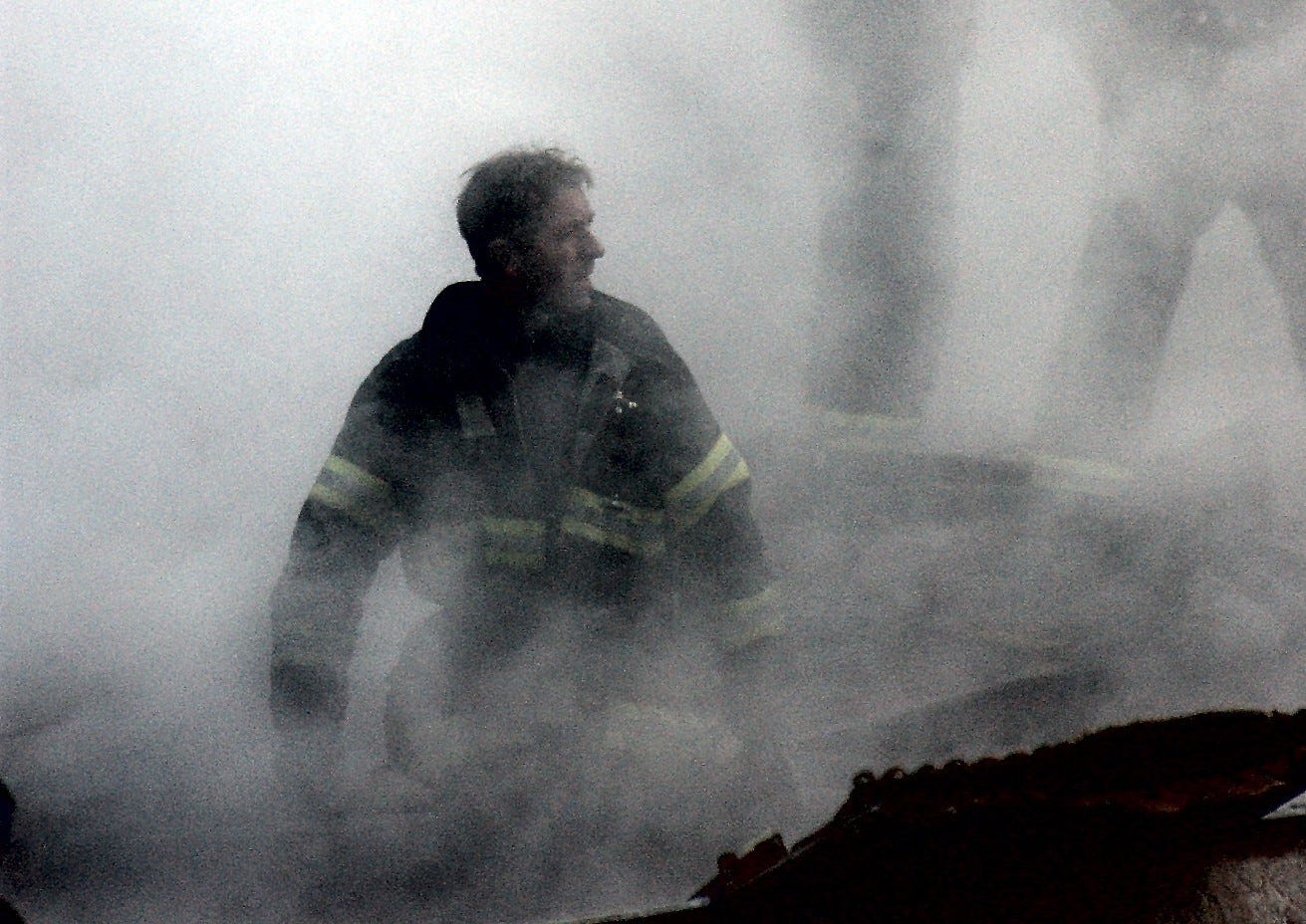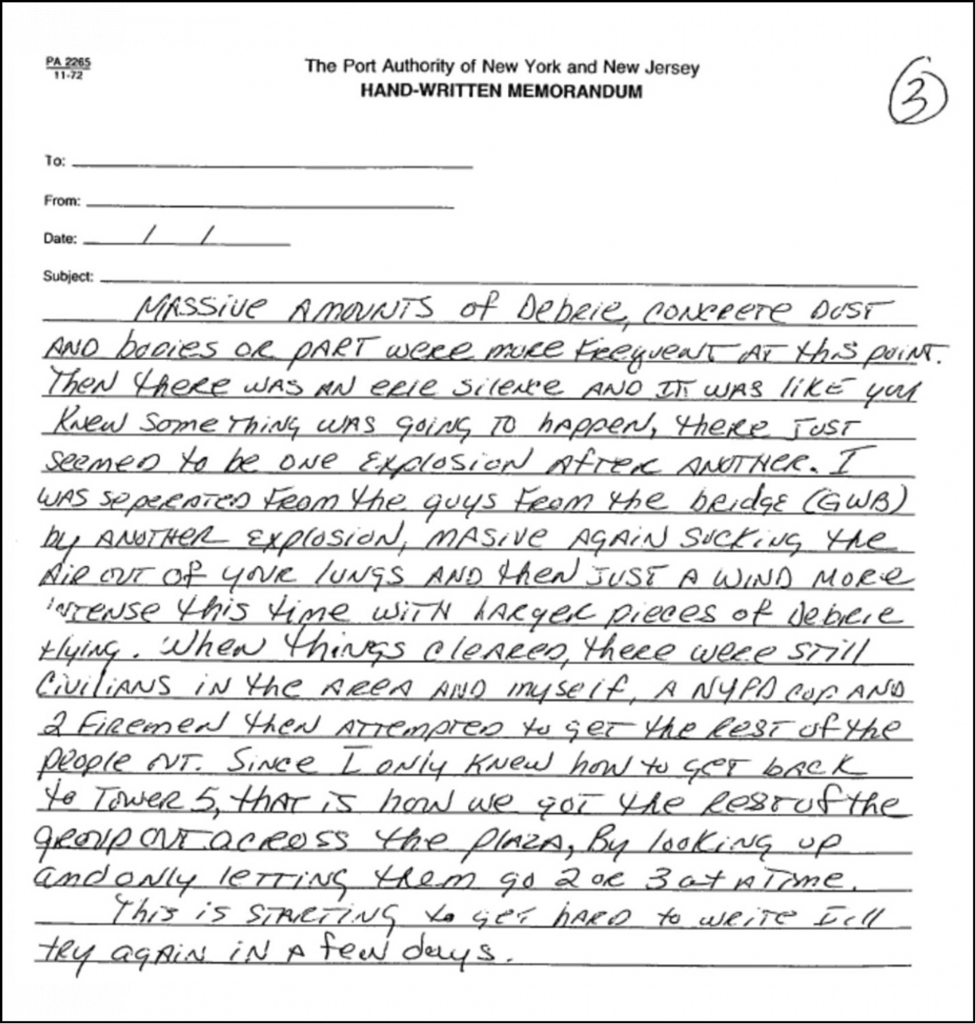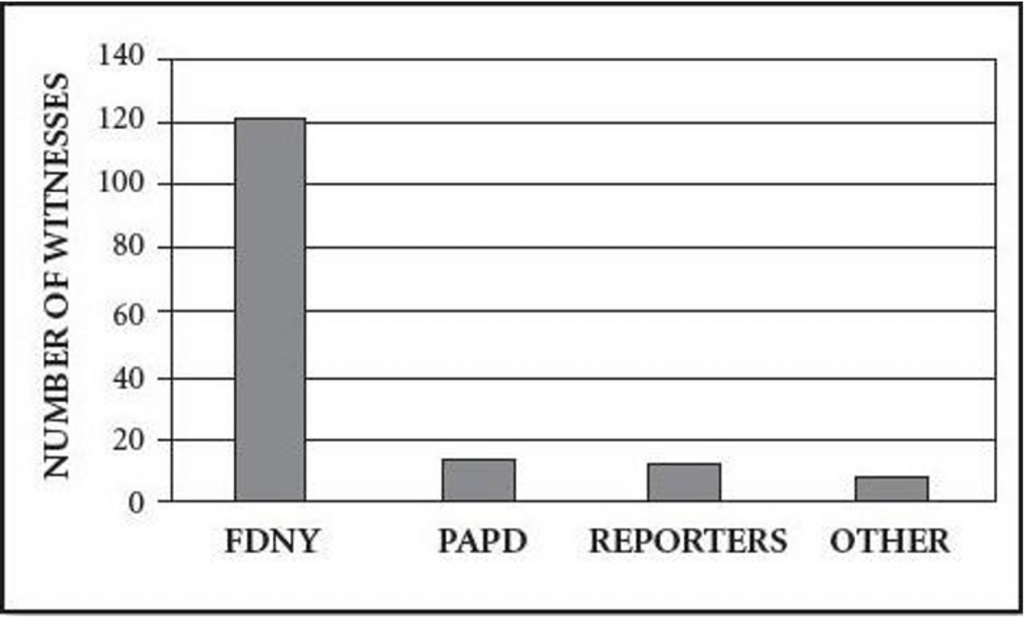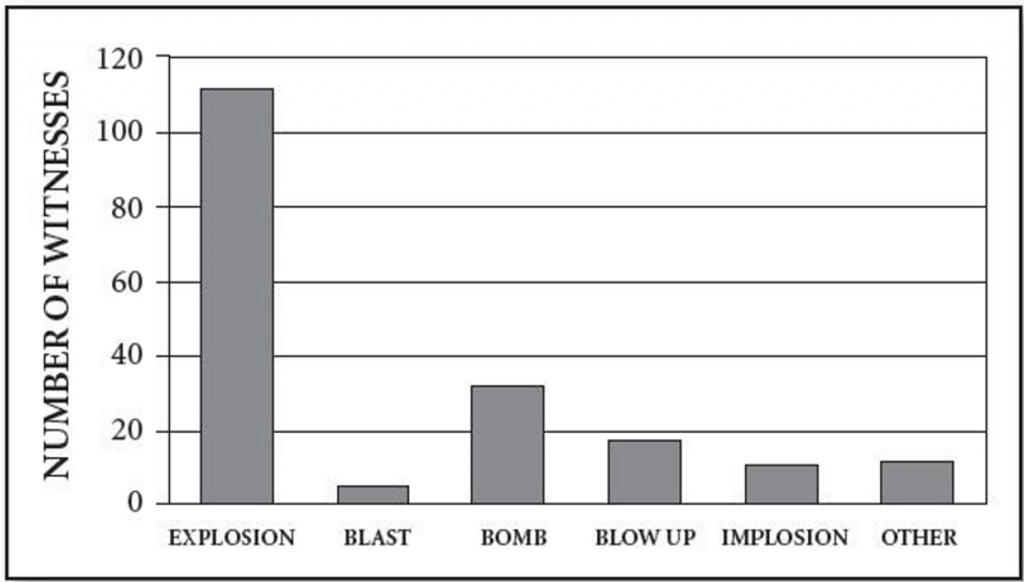9/11 Eyewitness Evidence of Explosions in the Twin Towers
Posted on July 21, 2023

Graeme MacQueen
Propaganda in Focus
Many of us are convinced that the twin towers of the World Trade Center were brought down on September 11, 2001 through controlled demolition. But the question at once arises: if this is what happened, would somebody not have noticed?
The answer is that many people did notice. There is a good deal of eyewitness evidence for the demolition of buildings 1 and 2. This paper will give a brief overview of this evidence.
[…]
The oral histories were collected by the World Trade Center Task Force of the FDNY after New York City fire commissioner Thomas Von Essen decided it would be important to have a record of what the members of the department experienced on that day. The Task Force interviews comprise 10-12,000 pages of statements by approximately 500 “FDNY firefighters, emergency medical technicians and paramedics collected from early October, 2001 to late January, 2002” (258).
Professor David Ray Griffin, with the help of able researchers, was the first scholar to ferret out fascinating descriptions of explosions from this material (259). The author of the present paper published a subsequent article after reading the oral histories, “118 Witnesses: the Firefighters’ Testimony to Explosions in the Twin Towers” (260).
The presentation and analysis below build on this earlier work. As the evidence is presented, three important points will emerge. First, the conviction that the Towers came down because of explosions was common on 9/11. Second, there is substantial eyewitness evidence supporting this conviction. Third, this evidence has been ignored or suppressed by both the 9/11 Commission and NIST.
[…]
Zoda says, as he moves his hand: “Floor by floor, it started poppin’ out.” Tardio concurs and uses the same hand gesture: “It was as if they had detonated, detonated (Zoda: “Yeah, detonated, yeah”), you know, as if they were planted to take down a building: boom, boom, boom, boom, boom, boom, boom.” Zoda adds: “All the way down. I was watching and running.”
These are firefighters and they are used to encountering the standard sorts of explosions that occur in building fires. But they do not talk about smoke explosions, or “boiling-liquid-expanding-vapor” (BLEVE) explosions, or any of the other expected forms of explosion. Instead, they are talking about, and acting out with dramatic gestures, something altogether different. They say that what they saw resembled a controlled demolition.
[…]
[…]
Ross Milanytch, an employee at nearby Chase Manhattan Bank, says of the South Tower: “It started exploding…It was about the 70th floor. And each second another floor exploded out for about eight floors, before the cloud obscured it all.”
John Bussey, a reporter for the Wall Street Journal, said this of the South Tower:
[…]
The handwritten PAPD report of this brave and obviously traumatized individual, which corroborates the above account in several crucial respects, is directly available in the PAPD documents released in 2003 (272). One page of that report is reproduced as follows.

It is difficult to formulate a complete account of eyewitnesses who describe, expressly or implicitly, explosions near the time of the destruction of the Twin Towers. Neither the FBI, nor the 9/11 Commission, nor the National Institute of Standards and Technology have published a count. I have compiled the most complete known list of witnesses to explosions at the Twin Towers. There are 156 such witness statements. The two graphs presented below summarize certain aspects of the list.

[,,,]
The “explosion” category is by far the largest, with 112 eyewitnesses. However, the “bomb” category, with 32 eyewitnesses, is extremely important as well. Most of the people on this list speaking of bombs are firefighters, and it is clear from their use of the word “bomb” that they are not talking about the sort of explosion they expect to encounter in a high-rise fire.
[…]

The types of explosions that typically accompany a fire are described in detail in various publications, probably most authoritatively in the National Fire Protection Association’s Guide for Fire and Explosion Investigations. There the NFPA describes four types of explosion that would have been expected to accompany the fires in the Twin Towers.
There are three characteristics of the eyewitness statements that rule out all four types of explosion. That is, these four sorts of explosions may well have occurred, but they do not account for the main explosions witnesses say they perceived. Here are the three characteristics that must be explained.
[…]
Via https://propagandainfocus.substack.com/p/eyewitness-evidence-of-explosions-in-the-twin-towers
THANKS TO: https://stuartbramhall.wordpress.com/2023/07/21/9-11-eyewitness-evidence-of-explosions-in-the-twin-towers/
Posted on July 21, 2023

Graeme MacQueen
Propaganda in Focus
Many of us are convinced that the twin towers of the World Trade Center were brought down on September 11, 2001 through controlled demolition. But the question at once arises: if this is what happened, would somebody not have noticed?
The answer is that many people did notice. There is a good deal of eyewitness evidence for the demolition of buildings 1 and 2. This paper will give a brief overview of this evidence.
[…]
The oral histories were collected by the World Trade Center Task Force of the FDNY after New York City fire commissioner Thomas Von Essen decided it would be important to have a record of what the members of the department experienced on that day. The Task Force interviews comprise 10-12,000 pages of statements by approximately 500 “FDNY firefighters, emergency medical technicians and paramedics collected from early October, 2001 to late January, 2002” (258).
Professor David Ray Griffin, with the help of able researchers, was the first scholar to ferret out fascinating descriptions of explosions from this material (259). The author of the present paper published a subsequent article after reading the oral histories, “118 Witnesses: the Firefighters’ Testimony to Explosions in the Twin Towers” (260).
The presentation and analysis below build on this earlier work. As the evidence is presented, three important points will emerge. First, the conviction that the Towers came down because of explosions was common on 9/11. Second, there is substantial eyewitness evidence supporting this conviction. Third, this evidence has been ignored or suppressed by both the 9/11 Commission and NIST.
The explosion hypothesis was common on 9/11
[…]- In a video clip preserved from 9/11, ABC television reporter N. J. Burkett is seen standing close to the Twin Towers. He draws our attention to the firefighters at the scene and to the burning buildings themselves. Suddenly, the South Tower begins to come apart behind him. As the pulverized debris shoots into the air, Burkett says: “A huge explosion now, raining debris on all of us. We better get out of the way!” Mr. Burkett’s statement shows no evidence of over-thinking the situation or of a conspiratorial mindset. He certainly did not come along after 9/11: he expressed his judgment before the debris of the building had even reached the ground. Then he ran for his life. Half an hour later he would run for his life again as the North Tower came down (261).
- In CNN’s same-day coverage of the events of 9/11, Mayor Giuliani was asked questions about explosions in the Twin Towers on two separate occasions. The second occasion is a press conference at about 2:39 p.m. A female reporter (off screen) asks the Mayor: “Do you know anything about the cause of the explosions that brought the two buildings down? Was it caused by the planes or by something else?” (262). Notice that she does not ask if there were explosions: she assumes there were. She does not ask if these explosions brought down the Towers: she assumes they did. She merely wants to know what caused the explosions – the planes or “something else.”
- In footage known as the “Matthew Shapoff video,” acquired from NIST through a Freedom of Information Act request, there are several people (off screen) chatting while they watch the events at the World Trade Center unfold at a distance and film them with their video camera. Suddenly, through their camera we see the North Tower begin to throw pulverized debris in all directions in huge plumes as it disintegrates. After a horrified, “oh, my God!” we hear a male voice, presumably that of Shapoff, exclaim as follows: “That was a bomb that did that! That was a fuckin’ bomb that did that! There’s no goddamn way that could have happened!” (263). Again, this is a spontaneous reaction to what Shapoff was observing.
- New York firefighter Christopher Fenyo, in a passage from the World Trade Center Task Force interviews, speaks of a debate that began among firefighters who were on the scene. The debate started after the destruction of the South Tower but before the destruction of the North Tower – in other words, between about 10:00 and 10:30 a.m. “…At that point a debate began to rage because the perception was that the building looked like it had been taken out with charges.” As with Shapoff, the statement concerns not just explosions generally but the intentional destruction of the building with explosives. That is, people were already debating a subcategory of the explosion hypothesis, the controlled demolition hypothesis, before 10:30 on the morning of 9/11.
- The FBI’s name for its investigation of the 9/11 incidents is PENTTBOM, which stands for “Pentagon/Twin Towers Bombing Investigation.” Is it possible that when this name was assigned someone in the FBI thought a bombing had taken place? (Recall that according to the current official narrative there was no bombing at any of the affected locations.) On the day of 9/11, USA Today’s foreign correspondent Jack Kelley was seen telling his TV audience that the FBI’s “working theory” at that time was that “at the same time two planes hit the building…there was a car or truck packed with explosives underneath the building, which exploded at the same time and brought both of them down” (264). Given that Kelley was later shown to have routinely fabricated stories for USA Today, his allegations about the FBI would have to be corroborated. However, the general hypothesis ascribed here to the FBI – the buildings were brought down through the use of explosives – was common on 9/11. For example, Albert Turi, FDNY Chief of Safety, told NBC’s Pat Dawson not long after the destruction of the Towers that, in Dawson’s words, “according to his [Turi’s] theory he thinks that there were actually devices that were planted in the building” (265).
[…]
There is strong eyewitness evidence supporting the explosion hypothesis.
[…]Zoda says, as he moves his hand: “Floor by floor, it started poppin’ out.” Tardio concurs and uses the same hand gesture: “It was as if they had detonated, detonated (Zoda: “Yeah, detonated, yeah”), you know, as if they were planted to take down a building: boom, boom, boom, boom, boom, boom, boom.” Zoda adds: “All the way down. I was watching and running.”
These are firefighters and they are used to encountering the standard sorts of explosions that occur in building fires. But they do not talk about smoke explosions, or “boiling-liquid-expanding-vapor” (BLEVE) explosions, or any of the other expected forms of explosion. Instead, they are talking about, and acting out with dramatic gestures, something altogether different. They say that what they saw resembled a controlled demolition.
[…]
[…]
Ross Milanytch, an employee at nearby Chase Manhattan Bank, says of the South Tower: “It started exploding…It was about the 70th floor. And each second another floor exploded out for about eight floors, before the cloud obscured it all.”
John Bussey, a reporter for the Wall Street Journal, said this of the South Tower:
Kenneth Rogers of the New York Fire Department said this about his experience with the South Tower:“Off the phone, and collecting my thoughts for the next report, I heard metallic crashes and looked up out of the office window to see what seemed like perfectly synchronized explosions coming from each floor, spewing glass and metal outward. One after the other, from top to bottom, with a fraction of a second between, the floors blew to pieces.” (268)
“…we were standing there with about five companies and we were just waiting for our assignment and then there was an explosion in the south tower… A lot of guys left at that point. I kept watching. Floor after floor after floor. One floor under another after another and when it hit about the fifth floor, I figured it was a bomb, because it looked like a synchronized
[…]
The handwritten PAPD report of this brave and obviously traumatized individual, which corroborates the above account in several crucial respects, is directly available in the PAPD documents released in 2003 (272). One page of that report is reproduced as follows.

Quantity
It is difficult to formulate a complete account of eyewitnesses who describe, expressly or implicitly, explosions near the time of the destruction of the Twin Towers. Neither the FBI, nor the 9/11 Commission, nor the National Institute of Standards and Technology have published a count. I have compiled the most complete known list of witnesses to explosions at the Twin Towers. There are 156 such witness statements. The two graphs presented below summarize certain aspects of the list.
FIGURE 8-1: WITNESSES BY PROFESSION/AGENCY

[,,,]
The “explosion” category is by far the largest, with 112 eyewitnesses. However, the “bomb” category, with 32 eyewitnesses, is extremely important as well. Most of the people on this list speaking of bombs are firefighters, and it is clear from their use of the word “bomb” that they are not talking about the sort of explosion they expect to encounter in a high-rise fire.
[…]
FIGURE 8-2: WITNESSES BY TERM USED

The types of explosions that typically accompany a fire are described in detail in various publications, probably most authoritatively in the National Fire Protection Association’s Guide for Fire and Explosion Investigations. There the NFPA describes four types of explosion that would have been expected to accompany the fires in the Twin Towers.
- BLEVE (“boiling-liquid-expanding-vapor-explosion,” as with an exploding boiler)
- Electrical explosion
- Smoke explosion (i.e. backdraft)
- Combustion explosion (e.g., natural gas, jet fuel vapor)
There are three characteristics of the eyewitness statements that rule out all four types of explosion. That is, these four sorts of explosions may well have occurred, but they do not account for the main explosions witnesses say they perceived. Here are the three characteristics that must be explained.
[…]
Via https://propagandainfocus.substack.com/p/eyewitness-evidence-of-explosions-in-the-twin-towers
THANKS TO: https://stuartbramhall.wordpress.com/2023/07/21/9-11-eyewitness-evidence-of-explosions-in-the-twin-towers/






 Sat Mar 23, 2024 11:33 pm by globalturbo
Sat Mar 23, 2024 11:33 pm by globalturbo

